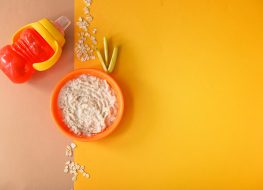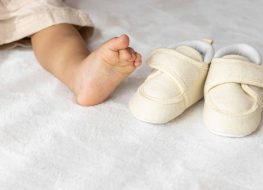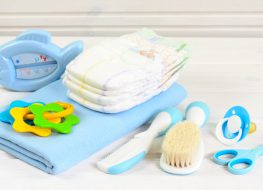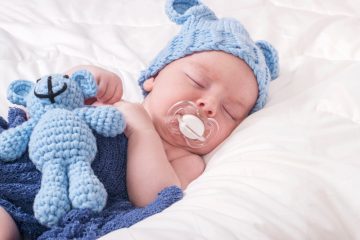
As parents, doing everything to create a safe life for your children comes naturally. After all, it’s easy to soothe their cries and keep them content in their bed. One of the most common practices for newborns is introducing them to a pacifier.
Still, questions linger over if introducing pacifiers to a newborn is okay (and not okay), are pacifiers bad, how soon to introduce pacifiers, and whether they pose any risks that could lead to Sudden Infant Death Syndrome (SIDS). Let’s tell you the answers to these questions so that your little one can benefit from a pacifier safely!
What Is Sudden Infant Death Syndrome?
SIDS is a diagnosis given to infants who die for no apparent reason. After a checkup, autopsy, and a review of the baby’s medical background without any certain cause of the death, the case will be declared as SIDS.
Death usually happens while babies are asleep and in their cribs, so SIDS is also known as “crib death.” Until today, experts cannot pinpoint the causes of SIDS, but some research has found that certain situations can increase its risk.
Can Pacifier Use Cause SIDS?
Even if the causes of SIDS are still unknown, what’s clear is that pacifiers aren’t included in the practices and activities that increase the risk of SIDS. However, although pacifiers aren’t directly mentioned in research, one practice may be related to it—proper breathing and sufficient oxygen supply.
Studies show that when a baby cannot breathe well, does not have enough oxygen, breathes in carbon dioxide instead, and cannot react or wake up to change this situation, they may suffer SIDS. Infants who sleep with pacifiers can only breathe through their nose, affecting proper breathing and making them prone to SIDS.
Aside from insufficient oxygen, here are risk factors experts have found:
- Babies sleeping on their tummy: When infants sleep on their tummies and they exhale, the air hits the mattress, pillow, or bed and bounces back to their face. With this, they breathe in the carbon dioxide they breathe out.
- Overheating: Keeping the right body temperature for the baby is essential, but getting them all wrapped may cause overheating and SIDS.
- Cluttered sleeping spaces: Blankets, pillows, and toys increase the risk of SIDS as babies can cling to them, accidentally cover their faces, and suffocate.
- Cosleeping: Accidents causing the baby to suffocate increase when they are co-sleeping with other people.
- Exposure to smoke: Mothers’ exposure to cigarette smoke while pregnant and the exposure of babies to it in their newborn months increase the risk of SIDS.
- Teenage pregnancy: Mothers who give birth at the age of 20 and below have babies at a higher risk of experiencing SIDS.
- Preterm infants: Premature babies are more prone to SIDS.
- Hereditary: Babies who have siblings who have died of SIDS have a higher risk of SIDS.
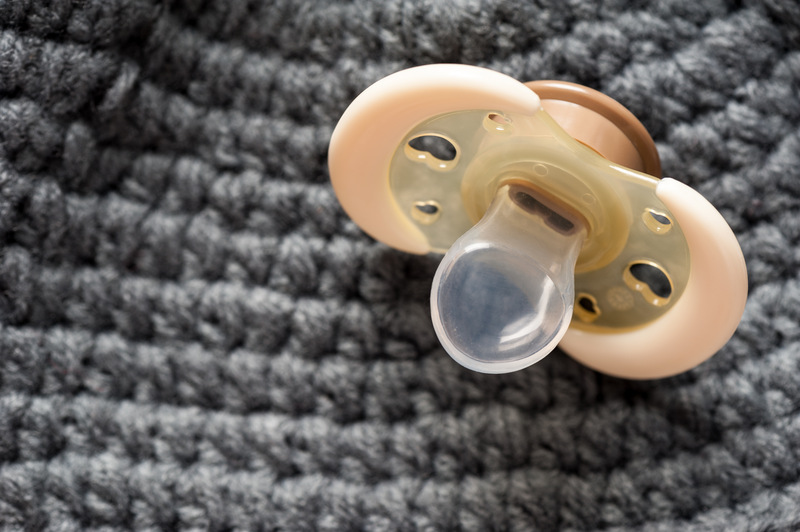
How Can You Reduce the Risk of SIDS?
Although the natural causes of SIDS aren’t found yet, you can reduce the risk for your little one through these practices.
Tilt the Baby’s Neck Away From Any Air Obstructions
To ensure your baby has enough oxygen, tilt their neck away from any air obstruction. It would also be best to free the crib from any clutter. Besides, your little one does not need any pillows or toys yet. These are only suffocation accidents waiting to happen.
Ensure the Baby’s Mouth and Nose Are Free From Obstructions
Aside from the external obstructions, make it a habit to check your little one’s nose and mouth too. When sleeping, it would be best to pause breast or bottle feeding to ensure your little one can breathe properly.
Have a Separate Crib
Co-sleeping has a lot of benefits. First, it allows you to feed your baby conveniently anytime in the same bed. You can also easily comfort your little one when they cry. However, co-sleeping also poses SIDS risks. Invest in a bedside crib if you want to stay close to your baby when sleeping. Your baby can still lay beside you, but they’ll have their own space.
Be Healthy Parents.
Parents can also cause their babies to suffer SIDS when they smoke during pregnancy. So, make it a vow to skip the smoke once you’ve conceived. And continue this after your baby arrives to avoid your little one inhaling toxic smoke from cigarettes.
Give Just the Right Amount of Warmth
Newborn babies need assistance in regulating their body temperature. This is why many parents are nitpicky about the clothes newborns wear; there are also socks, mittens, and swaddles for extra warmth.
Since overheating may cause SIDS, add just the correct amount of clothing and layers on your baby. It would also help to warm the room, so your little one can wear fewer layers.
When To Introduce a Pacifier?
If pacifiers aren’t mentioned in studies as something that increases the risk of SIDS, then it is generally safe to use! Nevertheless, as a parent, being careful is always the key to safety. You may have many questions, including when to use it, and here are the answers.
During a Breastfeeding Break
It is best to introduce a pacifier in the second month when you and your baby already have an established breastfeeding schedule. Offering it too early may confuse the baby between being breastfed and sucking on a pacifier. Because of the nipple confusion, babies may refuse to breastfeed and prefer rubber nipples, affecting breastfeeding continuity.
In Preparation for Bottle Feeding
Many breastfeeding babies need to adjust when introduced to bottle feeding, and one way is to use rubber nipples through a baby’s pacifier. Have a break time in bottle feeding training, inserting a week or two for pacifier practice. Then, begin offering bottles. Your baby will easily accustom themselves to the bottle nipple, though they’ll need to get used to drinking milk from the bottle compared to an empty pacifier.
When Introducing to Solid Food
There are different pacifiers, and there is one specially designed to be given to babies before or when they begin taking in solids: the fruit feeder pacifier. You can put fruits and more frozen and mashed food inside the pacifier, skipping non-nutritive sucking. When your baby sucks on it, they’ll be introduced to various flavors and textures. As a result, they’ll be more welcoming to solid food when they can finally eat.
For Pain Relief When Teething
Pacifiers are also self-soothing to little ones who are teething. Just fill a fruit feeder pacifier with frozen fruits and food so they can suck on something cold. The chilly temperature can ease their swollen gums while they get nutrition from the treats.
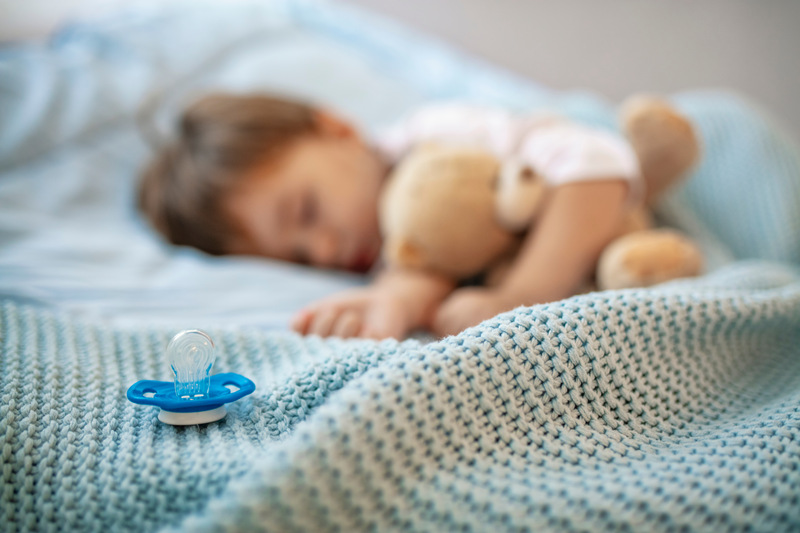
How Can Babies Use Pacifiers Safely?
You’ve already learned to take the pacifier from a sleeping baby. Now, here are more pacifier safety tips you can follow to ensure your little one’s comfort.
Check the Materials
Like what you do for everything you buy for your baby, always check what the item is made of. Make sure to grab medical-grade silicone pacifiers, and avoid getting pacifiers with harmful chemicals like BPA, BPA substitutes, and phthalates.
Use Pacifiers Correctly
If you are using pacifier clips for a traditional pacifier, make sure they are clipped perfectly to your little one’s clothing, so they won’t have the chance to chew on the clip instead of the pacifier. Choose plain strings and not those with beads, as they might break and become a choking hazard for your baby.
Practice extra caution in using the fruit feeder pacifier. Make sure that the pacifier locks are sealed to avoid babies getting to the fruit inside, which may cause choking.
Watch Out for Defects
Check the pacifier every day, every time you wash and clean it. Replace pacifiers that are broken as your baby might swallow plastic pieces or the pieces of food inside the pacifier. Check the fruit feeder pacifier’s lock. Look to see if the pacifier clips and strings are in perfect condition. Always check the pacifier’s quality before handing it over to your child!
Keep the Pacifier Clean
Bacteria multiply faster in wet areas, and there’s no better place to propagate than in pacifiers wet with saliva. With that, clean the pacifier as often as you can. Use hot water to ensure bacteria are killed. Utilize pacifier clips to keep the pacifier from falling on the ground. And if it falls, clean and dry it before giving it to your baby again.
Check Out Pacifiers From Ashtonbee
It’s never too early to learn about baby safety tips and SIDS. Ultimately, having clear information will give parents more control over how they handle the introduction and usage of pacifiers for their children’s safety and well-being. Thus, if done with consideration, your baby can enjoy the comfort of a high-end pacifier!
That’s why we at Ashtonbee make sure all of our pacifiers are made with safe and certified materials; this way, you can trust us completely with your baby’s safety. Check out what we have now and get one for your baby!

